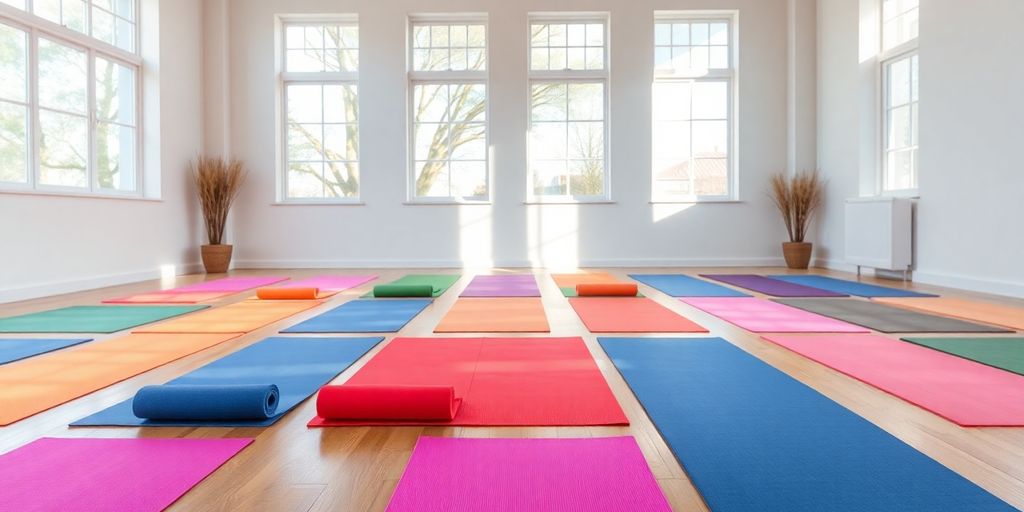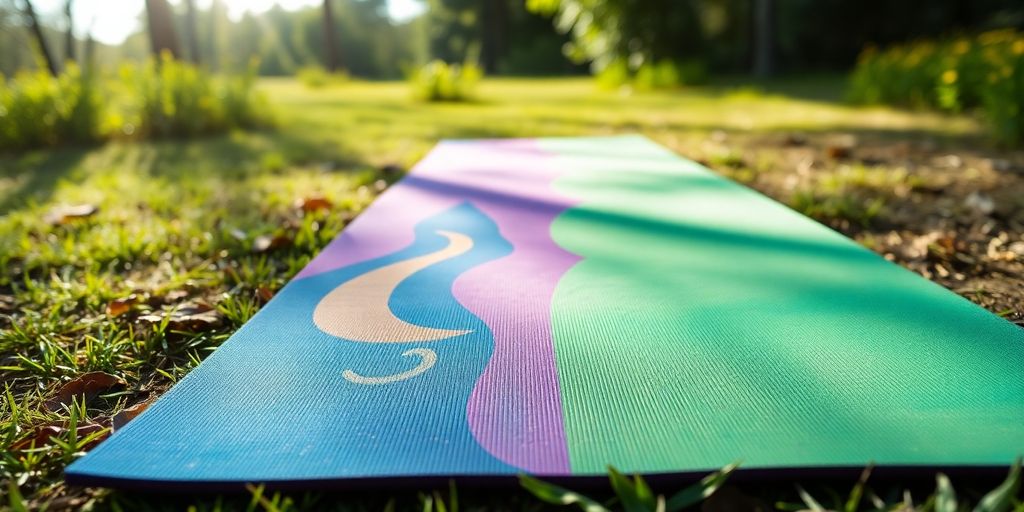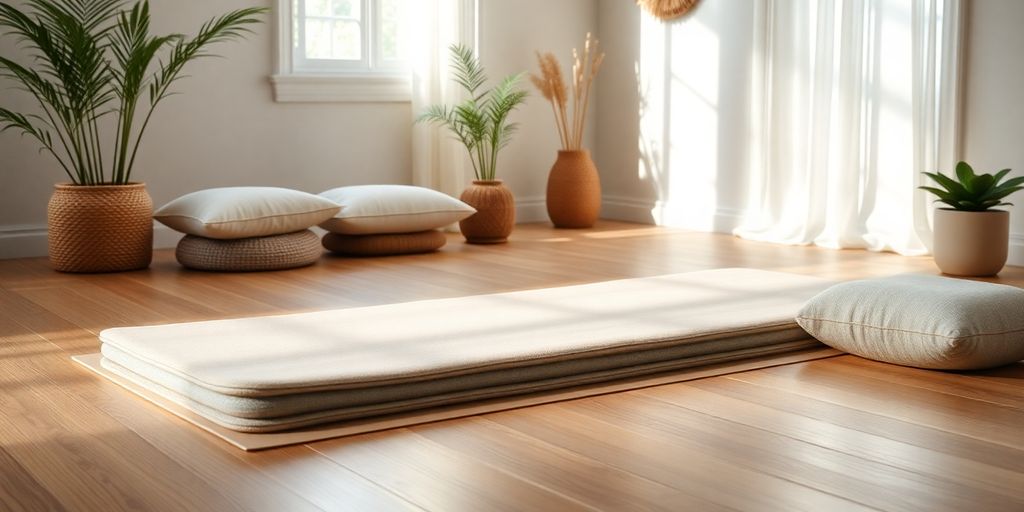
Discovering the Best Quality Yoga Mats for Your Practice in 2025
Yoga mats aren't just for keeping your feet off the cold floor; they're your foundation for a good practice. In 2025, finding a quality yoga mat can make a world of difference. Whether you're just starting out or have been at it for years, the right mat can offer stability, comfort, and support. Let's explore what makes a yoga mat stand out and how you can find the one that fits your practice perfectly.
Key Takeaways
- The material of a yoga mat affects grip and durability, making it essential for a quality practice.
- Thickness plays a key role in providing comfort and support, especially for joint protection.
- Eco-friendly yoga mats are increasingly popular among those who want sustainable options.
- Portability is crucial for yogis on the go, with lightweight mats being preferred for travel.
- Investing in a quality mat can enhance your yoga experience by offering better stability and comfort.
Understanding the Importance of Quality Yoga Mats
Why Material Matters in Yoga Mats
When you're choosing a yoga mat, the material is a big deal. It affects everything from grip to comfort to durability. Mats come in various materials like PVC, rubber, and cork, each offering different benefits. PVC mats are known for their durability and affordability, but if you're eco-conscious, natural rubber or cork might be more your style. The material you choose impacts not just your practice but also the environment. It's worth considering what aligns with your values and your yoga goals.
The Role of Thickness in Comfort and Support
Thickness is another key aspect when picking a yoga mat. A thicker mat, like The Obelisk Yoga Mat, offers more cushioning, which can be great for protecting your joints during poses. However, if you're doing a lot of balance work, a thinner mat might provide better stability. Generally, mats range from 1/16 inch to 1/4 inch thick. It's all about finding that sweet spot where comfort meets functionality for your specific practice.
Eco-Friendly Options for the Conscious Yogi
For those who care about the planet, eco-friendly yoga mats are a fantastic choice. These mats are made from sustainable materials like recycled rubber or natural cork. They're free from harmful chemicals and often biodegradable. As more people become aware of their environmental impact, the demand for these mats is growing. Choosing an eco-friendly mat not only supports your practice but also contributes to a healthier planet. It's a small step that makes a big difference.
Top Features to Look for in a Yoga Mat
Grip and Stability: Essential for Every Pose
When you're striking a pose, the last thing you want is to slip and slide around. Grip is everything in a yoga mat. Whether you're holding a downward dog or transitioning into warrior pose, a mat with a non-slip surface keeps you grounded. Check out the Aomame Yoga Mat for its non-slip design, perfect for maintaining stability during intense workouts.
- Look for mats with textured surfaces that provide excellent traction.
- Consider mats that perform well even when wet, especially if you enjoy hot yoga.
- Test the mat's grip by trying a few poses before buying.
Durability: Investing in Long-Lasting Mats
Yoga mats endure a lot of wear and tear, so durability is key. A mat that lasts not only saves money but also reduces waste. Many mats, like the Manduka PRO, are designed to withstand years of practice without losing their shape or comfort.
- Choose mats made from high-quality materials that resist tearing and stretching.
- Look for mats with a closed-cell construction to prevent moisture and bacteria buildup.
- Consider the thickness and density, which can affect both durability and comfort.
Portability: Finding the Right Mat for Travel
If you're a yogi on the go, portability is crucial. Lightweight mats are easier to carry to classes or on trips, but they shouldn't compromise on comfort or grip.
- Opt for mats that are easy to roll up and fit into a bag.
- Consider the weight of the mat if you plan to carry it around frequently.
- Look for foldable options that don't take up much space in your luggage.
A great yoga mat is like a trusty companion on your yoga journey. It should support you through every pose, last through countless sessions, and be easy to take wherever you go. Choosing the right mat involves balancing grip, durability, and portability, ensuring that your practice is both enjoyable and effective.
Exploring Different Types of Yoga Mats
Natural Rubber Mats: A Sustainable Choice
When it comes to finding the ideal yoga mat, natural rubber mats are often the go-to for eco-conscious yogis. These mats are made from renewable resources, offering a biodegradable option that doesn’t compromise on performance. They provide excellent grip and cushioning, making them perfect for both beginners and seasoned practitioners. Natural rubber mats are heavier, but they deliver a solid, grounded feel that many appreciate during intense sessions.
PVC Mats: Balancing Cost and Performance
PVC mats are popular due to their durability and affordability. They are known for their sticky texture, which helps maintain stability during poses. While not as eco-friendly as other options, advancements in manufacturing have led to PVC mats that are now latex-free and designed to last longer. These mats are often a top choice for those who practice frequently and need a mat that can withstand heavy use.
Cork Mats: Embracing Natural Materials
Cork mats are gaining traction for their natural feel and excellent grip, especially when wet. They are made from renewable cork material, providing a unique texture that becomes more stable as you sweat. Cork mats are naturally antimicrobial, which helps in maintaining hygiene. These mats might be slightly pricier, but for many, the combination of eco-friendliness and performance is worth the investment.
Choosing the right yoga mat is like finding a good pair of shoes. It's about comfort, support, and how it complements your practice style. Whether you opt for natural rubber, PVC, or cork, each has its own set of benefits that can enhance your yoga journey.
How to Choose the Right Yoga Mat for Your Practice
Matching Your Mat to Your Yoga Style
Picking the right yoga mat can feel a bit like finding a good pair of shoes. You want something that fits your style and feels comfortable. If you're just starting out, you might not want to spend too much. A good all-around mat with decent traction and cushioning is a great start. For those into flow or vinyasa, look for a mat with excellent grip, especially when wet. This is crucial for those quick transitions. And if hot yoga is your thing, a closed-cell mat that won't soak up sweat is your best bet.
Considering Your Personal Comfort Needs
Comfort is king when it comes to yoga mats. If you're into restorative yoga, where you spend a lot of time on the floor, you'll want something thick and cushy. But, if you're more about balance and standing poses, a thinner mat might give you better stability. Some folks like to pair a sturdy mat with a blanket for extra comfort during seated poses.
Evaluating the Price vs. Quality Trade-off
Let's be real, yoga mats can get pricey. But investing in a good one is worth it. Think about how often you'll use it. A durable mat might cost more upfront but will last longer, saving you money in the long run. Look for mats that balance cost and performance, like those made from eco-friendly materials. They might be a bit more expensive, but they're better for the planet and often last longer.
A yoga mat isn't just a piece of gear; it's your practice buddy. Treat it well, and it'll support you through countless sessions. Whether you're sweating it out in hot yoga or finding your zen in a quiet room, the right mat makes all the difference.
Maintaining and Caring for Your Yoga Mat

Cleaning Tips for Longevity
Keeping your yoga mat clean is key to making it last. After every session, give it a quick wipe down. Use a mix of mild soap and water, or a specialized mat cleaner. This not only keeps it fresh but also keeps those unwanted odors at bay. Let it air dry completely before you roll it up. If you're using a mat like the TI22 Yoga Mat by Yune Yoga, which is moisture-resistant, cleaning becomes a breeze.
Proper Storage Techniques to Extend Life
How you store your mat can make a big difference in how long it lasts. Keep it in a cool, dry place, away from direct sunlight. Sunlight can break down the material over time, causing it to lose its grip and color. Roll it up loosely to avoid creases and, if possible, store it upright. This simple practice can help maintain its shape and functionality.
When to Replace Your Yoga Mat
A yoga mat is an investment in your practice, and with good care, it can last for years. However, there are signs that it's time to let go and get a new one:
- Loss of Grip: If you find yourself slipping more frequently, it might be time for a new mat.
- Visible Wear and Tear: Look for cracks, peeling, or deep creases as indicators that your mat is past its prime.
- Persistent Odor: If your mat retains an unpleasant smell even after cleaning, it's probably time for a replacement.
A yoga mat is more than just a piece of equipment; it's your partner in practice. Treat it well, and it will support you for many sessions to come.
The Best Yoga Mats for Hot Yoga in 2025
Non-Slip Mats for Sweaty Sessions
When you're deep into a hot yoga session, the last thing you want is to slip and slide all over your mat. Non-slip mats are a game-changer for anyone who finds themselves in a pool of sweat halfway through a workout. Look for mats with superior grip technology, like open-cell surfaces that absorb moisture and enhance traction. Materials such as natural rubber or polyurethane are often recommended for their sticky nature, which becomes even grippier as you sweat.
Top Picks for Hot Yoga Enthusiasts
Here's a quick rundown of some of the best mats to consider:
- Yune Yoga Mat in Hatsumi Orange: This mat shines with its 5mm thickness and non-slip design, perfect for stability during intense sessions. It's made from eco-friendly materials and is moisture-resistant, keeping it hygienic and easy to clean. Explore the Yune Yoga Mat.
- JadeYoga Harmony Mat: Known for its excellent grip and durability, this mat is a favorite among hot yoga practitioners. Its natural rubber construction provides a strong hold even in the sweatiest conditions.
- Lululemon The Mat 5mm: With a grippy top layer and ample cushioning, this mat is versatile for different practices, though slightly heavier to carry around.
Why Thickness Matters in Hot Yoga Mats
Thickness plays a crucial role in your comfort and performance. A thicker mat, usually around 5mm to 6mm, provides better cushioning for your joints, which is essential during long holds and intense stretches. It also helps in absorbing impact and reducing strain on your knees and elbows. However, too much thickness can compromise stability, so finding the right balance is key.
Choosing the right yoga mat for hot yoga is about balancing grip, thickness, and eco-friendliness. Whether you're a seasoned yogi or just starting, investing in a quality mat can make all the difference in your practice.
Eco-Friendly Yoga Mats: A Guide for 2025

Benefits of Choosing Eco-Friendly Mats
Choosing eco-friendly yoga mats is more than just a trend; it's a commitment to sustainability. These mats are crafted from materials like natural rubber, jute, and cork, which are biodegradable and non-toxic. By opting for eco-friendly mats, you're not only supporting environmental health but also enhancing your yoga experience with natural materials. These mats often offer superior grip and comfort, making them a favorite among yogis who care about the planet.
Top Brands Offering Sustainable Options
When it comes to eco-friendly yoga mats, several brands stand out for their commitment to sustainability. Brands like Manduka, Gaiam, and Liforme have been leading the charge with innovative eco-conscious designs. For instance, the Oak Yoga Mat is a top pick, offering a non-slip surface and being crafted from eco-friendly materials that are free from harmful chemicals. These brands not only focus on reducing their carbon footprint but also on providing high-quality products that last.
How to Identify Truly Eco-Friendly Products
Not all mats labeled as "eco-friendly" truly live up to the name. To ensure you're getting a genuinely sustainable product, look for certifications such as OEKO-TEX or GOTS. These certifications guarantee that the materials used are safe for both you and the environment. Additionally, consider the mat's end-of-life options – can it be recycled or composted? Understanding these aspects will help you make informed decisions and choose mats that align with your values.
Practicing yoga on an eco-friendly mat is a small yet significant step towards a more sustainable lifestyle. It's about making choices that reflect your commitment to the planet and your personal well-being. By selecting mats made from natural materials, you contribute to a healthier environment and a more mindful practice.
Yoga Mat Innovations to Watch in 2025
Technological Advances in Yoga Mats
In 2025, yoga mats are getting a tech upgrade. Imagine mats that can track your movements, offering feedback on your poses. Some high-tech mats even come with built-in sensors to monitor your alignment and balance. These innovations are designed to enhance your practice by providing real-time insights. This tech-savvy approach is perfect for those who love integrating gadgets into their routines.
Trends in Design and Functionality
Designs are also shifting towards more personalized and functional options. Expect to see mats that cater to specific yoga styles, whether it's hot yoga or restorative sessions. Some mats are now being crafted with adjustable thickness, allowing users to customize their comfort level. The JadeYoga Harmony Mat is a great example of a mat that balances both design and functionality, ensuring durability and portability.
The Future of Eco-Conscious Yoga Gear
Eco-friendliness is not just a trend; it's becoming a standard. In 2025, more brands are focusing on sustainable materials like natural rubber and cork. These materials not only reduce environmental impact but also offer excellent grip and durability. As consumers become more eco-aware, the demand for mats that are both sustainable and high-performing is on the rise. This shift is paving the way for a greener yoga practice.
Conclusion
So, there you have it! Finding the perfect yoga mat in 2025 is all about knowing what you need and what feels right for you. Whether you're all about that eco-friendly vibe, need extra cushioning for those tricky poses, or just want something that won't have you slipping all over the place, there's a mat out there with your name on it. Take your time, maybe try a few out, and don't forget to check out some reviews. Investing in a good mat is like giving yourself a little gift that keeps on giving. It'll be your trusty companion as you stretch, breathe, and find your zen. Happy yoga-ing!
Frequently Asked Questions
What should I look for when buying a yoga mat?
When buying a yoga mat, consider the material, thickness, and grip. Look for eco-friendly options if you're environmentally conscious. Make sure it's durable and portable if you travel often.
How do I clean my yoga mat?
To clean your yoga mat, use a mixture of water and mild soap. Wipe it down with a damp cloth and let it air dry. Avoid harsh chemicals as they can damage the mat.
Why is yoga mat thickness important?
Yoga mat thickness is important because it provides cushioning for your joints. Thicker mats offer more comfort, especially for poses that put pressure on your knees and elbows.
Are eco-friendly yoga mats worth it?
Eco-friendly yoga mats are worth it if you care about the environment. They are made from sustainable materials like natural rubber and are free from harmful chemicals.
How do I know when to replace my yoga mat?
Replace your yoga mat when it starts to lose its grip, shows signs of wear and tear, or if it develops an unpleasant smell that doesn't go away after cleaning.
Can I use the same yoga mat for different types of yoga?
Yes, you can use the same yoga mat for different types of yoga, but some mats are designed for specific practices like hot yoga. Consider your needs and preferences when choosing a mat.


